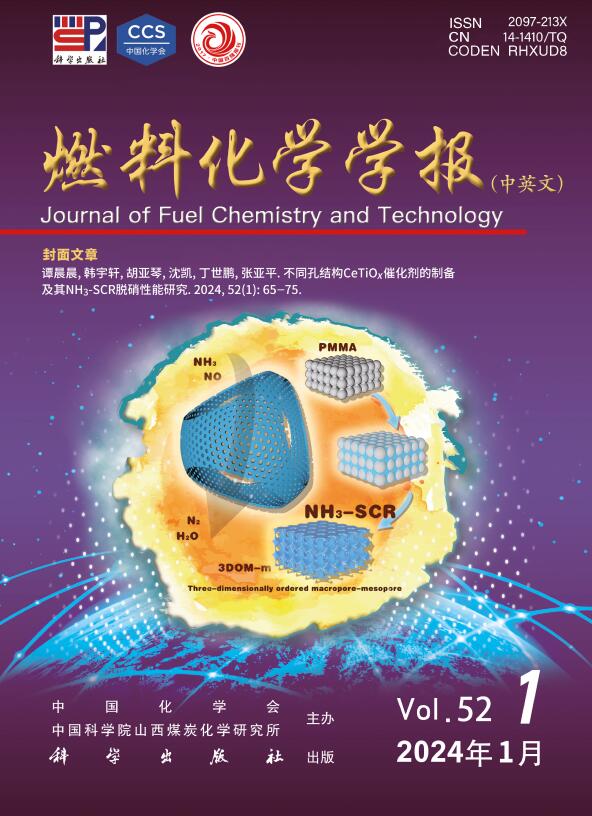Preparation and coking properties of binder pitch prepared by a two-step method of oxidation and mild-polymerization
Q3 Energy
引用次数: 0
Abstract
Production of high-quality binder pitch is important since it is one of the essential raw materials for artificial carbon/graphite electrodes. A two-step process of oxidation and mild polymerization were employed to develop binder pitches from four refined pitches produced from high-temperature coal tar pitches from various sources. Moreover, coking properties of the binder pitch were thoroughly investigated. Proximate, ultimate, FT-IR, optical, and thermogravimetric analyses were used to explore the fundamental physic-chemical properties of the binder pitch. Further, optical microscope, XRD, Raman spectrum, scanning electron microscope (SEM), and micro-strength were also used to determine micro-structure of binder pitch coke. The findings demonstrate that four refined high-temperature coal tar pitches could prepare binder pitches with optically isotropic, high aromatic, and strong thermal stability using the two-step process. The optical microstructure of binder pitch cokes produced using carbonization and thermal conversion methods comprised mainly of leaflets and contained a significant amount of regular carbon microcrystals. Among them, optical anisotropy index of the binder pitch coke reached 93%, and amount of β resin in binder pitch BP-KL reached 35.27%.
两步氧化-轻度聚合法制备粘结剂沥青及其焦化性能
高质量粘结剂沥青的生产是重要的,因为它是人造碳/石墨电极的重要原料之一。以不同来源的高温煤焦油沥青为原料,采用两步氧化和温和聚合法制备了四种精制沥青。此外,还对粘结剂沥青的焦化性能进行了深入的研究。采用近似分析、极限分析、红外光谱分析、光学分析和热重分析来探讨粘合剂沥青的基本物理化学性质。利用光学显微镜、x射线衍射(XRD)、拉曼光谱(Raman)、扫描电镜(SEM)和显微强度等对粘结剂沥青焦的微观结构进行了表征。研究结果表明,采用两步法制备的四种高温煤焦油沥青可制备具有光学各向同性、高芳香性和强热稳定性的粘结剂沥青。采用炭化法和热转化法制备的粘结剂沥青焦的光学显微结构主要由小叶状结构组成,并含有大量的规则碳微晶。其中粘结剂沥青焦的光学各向异性指数达到93%,粘结剂沥青BP-KL中β树脂的含量达到35.27%。
本文章由计算机程序翻译,如有差异,请以英文原文为准。
求助全文
约1分钟内获得全文
求助全文
来源期刊

燃料化学学报
Chemical Engineering-Chemical Engineering (all)
CiteScore
2.80
自引率
0.00%
发文量
5825
期刊介绍:
Journal of Fuel Chemistry and Technology (Ranliao Huaxue Xuebao) is a Chinese Academy of Sciences(CAS) journal started in 1956, sponsored by the Chinese Chemical Society and the Institute of Coal Chemistry, Chinese Academy of Sciences(CAS). The journal is published bimonthly by Science Press in China and widely distributed in about 20 countries. Journal of Fuel Chemistry and Technology publishes reports of both basic and applied research in the chemistry and chemical engineering of many energy sources, including that involved in the nature, processing and utilization of coal, petroleum, oil shale, natural gas, biomass and synfuels, as well as related subjects of increasing interest such as C1 chemistry, pollutions control and new catalytic materials. Types of publications include original research articles, short communications, research notes and reviews. Both domestic and international contributors are welcome. Manuscripts written in Chinese or English will be accepted. Additional English titles, abstracts and key words should be included in Chinese manuscripts. All manuscripts are subject to critical review by the editorial committee, which is composed of about 10 foreign and 50 Chinese experts in fuel science. Journal of Fuel Chemistry and Technology has been a source of primary research work in fuel chemistry as a Chinese core scientific periodical.
 求助内容:
求助内容: 应助结果提醒方式:
应助结果提醒方式:


